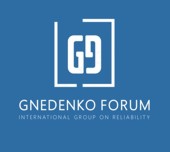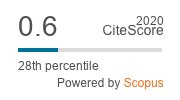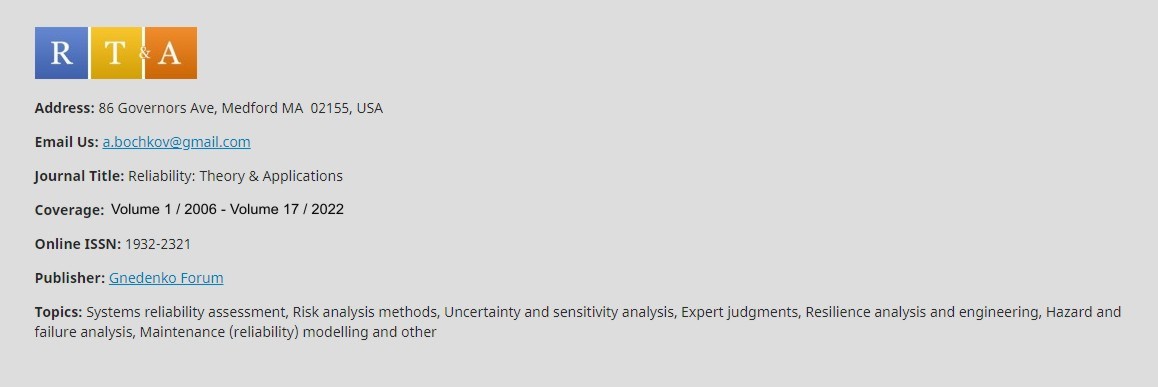|
About Us | Submission | Editorial Team | Privacy Statement | Current Issue | Templates & Author Guidelines | Archives | Contacts
|
||
|
|
With the rapid development of technology, complexity and economy have achieved unprecedented development and received extensive attention from the society and industry. Due to growing complexity, Reliability theory become important day by day. This special issue of the journal Reliability: Theory and Applications on Recent Communications in Reliability, Availability, Maintainability (RAM) & Associated Areas published high-quality articles of reliability engineering. We would like to express our gratitude to all the authors for submitting their work and to the reviewers for their efficient work in assessing the submissions. We are truly pleased by their excellent timely responses. The guest editors are also highly thankful to Managing Editor Prof. Alexander Bochkov for providing the continuous support and constructive suggestions during the review process and shaping the special issue. We hope that this special issue significant contributions in the field of reliability.
Dr. Nupur Goyal, Graphic Era Deemed to be
University, India, e-mail:
drnupurgoyal10jun@yahoo.com
Miltiadis Chalikias, Ioannis Triantafyllou, Michalis Skordoulis, Dimitris Kallivokas, Panagiota Lalou
DOI: https://doi.org/10.24412/1932-2321-2021-264-5-14
Putri Rahmatul Isti’anah, Yugowati Praharsi, Aditya Maharani, Hui-Ming Wee
DOI: https://doi.org/10.24412/1932-2321-2021-264-15-26
Ioannis S. Triantafyllou, Miltiadis Chalikias On Reliability Structures with Two Common Failure Criteria Under Age-Based Maintenance Policy
DOI: https://doi.org/10.24412/1932-2321-2021-264-27-34
Amitkumar Patil, Gunjan Soni, Anuj Prakash, Mangey Ram Intelligent Valve Fault Diagnosis Approach for Reciprocating Compressor Based on Acoustic Signals
Reciprocating compressor is one of the critical components in petrochemical, process and gas storage /transportation industry. Due to the dynamic operating conditions, valve failures of the compressors are one of the most frequent failures that causes around 36% of the unplanned shutdowns for reciprocating compressors. For reliable operations of the compressor, a conditionbased fault diagnosis model is proposed in this study. Majority of the existing studies are based on vibration, pressure and other intrusive sensors, which interferes with the system dynamics. Hence, non-intrusive acoustic sensor-based signal analysis technique is tested in this study. Due to the non-stationary nature of the acoustic signal obtained from the working compressor, it is quite difficult to extract fault-specific information. Hence, Minimum Entropy Deconvolution Adjusted (MEDA)-Empirical Mode Decomposition (EMD) approach is proposed for valve-fault diagnosis of reciprocating compressor. After enhancing the impulsiveness of the raw signals with the help of MEDA, a set of IMFs is obtained through EMD method. From this IMF-set, information rich IMF is selected based on the kurtosis value. For extraction of fault related information, two time-domain features (RMS and sample entropy) are used. The results show that MEDA can enhance the signal features effectively which is critical for fault detection. Compared to EMD method, the proposed methodology has shown promising results for inlet and outlet valve-fault diagnosis of reciprocating compressor.
DOI: https://doi.org/10.24412/1932-2321-2021-264-35-47
Adarsh Anand, Jasmine Kaur, Ompal Singh, Mangey Ram Optimal Resource Allocation for Software Development under Agile Framework
DOI: https://doi.org/10.24412/1932-2321-2021-264-48-58
Subhi Tyagi, Akshay Kumar, Mangey Ram, Seema Saini Signature Analysis of Bleaching and 2-out-of-4 Systems
DOI: https://doi.org/10.24412/1932-2321-2021-264-59-68
Shweta Agarwal, S. B. Singh
Reliability Analysis of Periodically Inspected
Systems under Imperfect Preventive Maintenance In this study a periodically inspected system is analyzed which is subject to imperfect maintenance policy. The considered system is inspected and maintained periodically and passes through a fixed number of imperfect repairs before being replaced. The imperfect effect of the preventive maintenance is modelled on the basis of the increasing failure rate of the system. Since the preventive maintenance is imperfect, it brings the considered system to an operating state which lies between two states, namely the “as bad as old state” and “as good as new state”. The distribution of the failure time of the system and that of the repair times are assumed to be arbitrary. The times required for the preventive maintenance of the system and its replacement are further assumed to be negligible. Incorporating the given facts, the reliability of the periodically inspected system is evaluated. Also, various reliability measures like availability, steady-state availability are estimated. An optimal interval of inspection is estimated so that the total cost in minimized. With the help of a case study on Nuclear Power Plant System (NPPS) the derived results are illustrated.
DOI: https://doi.org/10.24412/1932-2321-2021-264-69-81
Ramgopal Dhaka, Bhoopendra Pachauri, Anamika Jain Software is a set or group of programs and instructions, which is designed to perform a well-defined function. A software fault/error can be the cause of major productivity or economic loss. The need to determine the reliability of software led to development of the software reliability growth models (SRGMs). In research literature, exist various SRGMs which have been developed without considering fault removal time and only a few models have incorporated operating environment uncertainty. However, Most of the SRGMs are characterized under the condition that the software reliability enhancement process depends only on the testing time, which is called one-dimensional SRGM. In this article, two-dimensional SRGMs have been proposed using delay in debugging, with uncertainty in the operating environment. To represent the combined effect of used resources and testing time, the Cobb-Douglas production function has been used, which converts the one-dimensional model to two dimensional. For better understanding the results predictive analysis is performed and to validate the proposed model results are compared with existing SRGMs using five statistical comparison criteria.
DOI: https://doi.org/10.24412/1932-2321-2021-264-82-94
Palak Saxena, Vijay Kumar, Mangey Ram
Ranking of Software Reliability Growth Models: A
Entropy-ELECTRE Hybrid Approach Software reliability is estimated using software reliability growth models. In the last few decades, numerous software reliability growth models (SRGMs) have been established. Some models are developed with the consideration of perfect debugging, imperfect debugging, testing coverage, testing effort, and fault reduction factor. Generally, SRGMs are dependent on dataset and thus it is a challenging task to select SRGM appropriately based on the need of software user. As the inappropriate selection of SRGM can lead to inaccurate results and consequently delay in software release. To address this issue, we have combined the two multi-criteria decision-making (MCDM) approaches namely Entropy and Elimination et Choice Translating Reality (ELECTRE) methods. The proposed approach identifies the criterion importance as to select suitable SRGM, comparison of criteria is important. The outcomes are based on the aggregate value of dominant matrix that is being used for SRGMs ranking. The working of proposed Entropy-ELECTRE method is demonstrated on a real time data set on which ten SRGMs are compared against six evaluation criteria. The findings play an important role in determining the SRGM's appropriateness for decision-maker.
DOI: https://doi.org/10.24412/1932-2321-2021-264-95-113
Vijay Kumar Gahlawat, Indra, Kumar Rahul, Rahul S Mor, Mohit Malik
A Two State Time-Dependent Bulk Queue Model with
Intermittently Available Server This paper studies the time-dependent first-in-first-out (FIFO) queuing model with a single intermittently available server and variable-sized bulk arrivals and bulk departures. The time between arrivals, servicing time, and server availability time follows an exponential distribution. The difference-differential equations are used for developing system equations, and the Laplace transforms (L.T.), and inverse transforms are used for the solution. Explicit two-state transient recursive probabilities are obtained for an exact number of bulk arrivals and bulk departures, and in the end, few particular cases are derived.
DOI: https://doi.org/10.24412/1932-2321-2021-264-114-122
Surbhi Singhal, Monika Vishnoi
Flexible Production Inventory Model with Time
Dependent Holding Cost and Reliability Process The deterministic inventory model for decayed items concerns with reliability process and flexible production rate. The rate of decayed items is assumed to be a two parameters Weibull distribution. In this study, complete backlogging shortages are acceptable and holding cost is taken as linear. Further the influence of inflation has been developed and the model is established with numerically and sensitivity analysis which has been given the impact of parameters and also interpreted through graphically. The system is designed for the producer to validate the model to optimum level.
DOI: https://doi.org/10.24412/1932-2321-2021-264-123-131
Sandeep Kumar In present study an EOQ model is proposed for decaying items with constant demand in which the process of demand is related to the willingness to receive the good quality items by giving the power to the costumers of checking the quality of items before reaching the effective purchasing. The cost of disposing is also considered for unsold units alongside the regular costs for storage and acquirement. This study presents a mathematical analysis to acquire the EOQ policy under certain conditions. To minimize the total expected inventory cost, a linear decrement is assumed in purchasing during the cycle of product life. Then the optimal parameters are found for the model with the help of a numerical example. In the last a numerical sensitivity analysis is presented to prove that the traditional EOQ model for decaying items is approximated by the proposed study during the sufficiently large life cycle.
DOI: https://doi.org/10.24412/1932-2321-2021-264-132-141
Neelam Singla, Harwinder Kaur
A Two-State Retrial Queueing Model with Feedback and
Balking Present paper discusses a two-state retrial queueing model with feedback and balking. If a customer on arrival finds the server free it is served immediately. Else either it joins the retrial orbit as a secondary customer or balks from the system due to impatience. Primary and secondary arrivals both follow Poisson process. If the customer feels unsatisfied after service, it may join the orbit as a feedback customer. Service times follow Exponential distribution. The transient state probabilities for exact number of arrivals and departures when the server is busy or idle are obtained by solving difference-differential equations. Numerical solution is obtained and presented graphically.
DOI: https://doi.org/10.24412/1932-2321-2021-264-142-155
Kamal Kumar, Meenu Inventory Policy for Deteriorating Items with Two-Warehouse and Effect of Carbon Emission
DOI: https://doi.org/10.24412/1932-2321-2021-264-156-165
Sandeep Kumar In present climate of competition, each prime company wants to increase the planning of pricing in order to get more profit; controlling the cost of inventories is one of the finest policies of it. The present research study elaborates an order level inventory policy for perishable items where the rate of decay varies with time directly. The holding and ordering costs are taken the functions of time. The policies of optimality and decision rules are developed to optimize the total inventory cost,. The shortages are totally backlogged and allowed. A numerical example is given to explain and verify the study. In order to examine the effect of major parameters on decision-making, a sensitivity analysis is performed. Eventually, conclusions are presented along with some managerial perceptions.
DOI: https://doi.org/10.24412/1932-2321-2021-264-166-175
Paras Garg, Amitkumar Patil, Gunjan Soni, Arvind Keprate, Seemant Arora
Machine Learning-Based Abnormality Detection
Approach for Vacuum Pump Assembly Line The fundamental basis of Industry 4.0 is to make the manufacturing sector more productive and autonomous. In the manufacturing sector, practitioners always long for product quality improvement, reducing reworking costs, enhancing first pass yield in production or assembly line, in this regard anomaly detection, is becoming popular and is widely used. With the integration of anomaly detection models and Artificial Intelligence-based condition monitoring systems, industries have attained promising results in achieving these goals. However, it is a highly complex task to extract meaningful information from the large amount of data generated by the manufacturing systems. Hence, in this paper, effective machine-learning-based anomaly detection and prediction model has been proposed. A two-phase model is presented in this study and is validated for abnormality detection in the assembly line of vacuum pumps. In the first phase, a random forest algorithm is used to predict the pump vacuum. Based on the actual and predicted values, the error is computed. Then, EWMA (Exponentially Weighted Moving Average) chart is employed to detect the anomalies. In the second phase of the proposed model, based on the EWMA chart and calculated error, anomaly prediction is done. For better prediction results, statistical features are extracted from the error values and used as input for the second phase. To validate the proposed approach, other machine learning models SVR, Decision Tree, Logistic Regression, KNN and SVC have been compared. A statistical method EWMA chart is also integrated with random forest.
DOI: https://doi.org/10.24412/1932-2321-2021-264-176-187
Anuj Kumar, Ganga Negi, Sangeeta Pant, Mangey Ram, Sushil C. Dimri The challenge of upgrading the complex industrial systems is basically to cope up with the everincreasing demands of the real world. For the maximum reliability of complex industrial systems, decisions of management depend on experience. This is because the pattern of the chance of success is not easy to predict due to limited and rough available information. Thus, the task of the researchers lies here to increase the operational time of the individual components of a system for maintaining higher system reliability to increase productivity and profit of an organization. In this paper, an optimum choice of the mean time between failure (MTBF), mean time to repair (MTTR), and associated costs in a suitable design unit has been showcased to bring as much efficiency as possible. The motive is to minimize the cost satisfying the availability constraints of the system by using a few recent nature-inspired optimization techniques named Grey Wolf Optimization (GWO) technique and Cuckoo Search Algorithm (CSA). The computational parameters produced to improve the efficiency of the designed system with the application of GWO and CSA techniques, which not only achieve the target of minimum cost but also stand out much competitively in terms of performance. The results obtained by these two algorithms for butter oil processing system are compared and this comparative study shows that the GWO is superior to CSA for this availabilitycost optimization problem of butter oil processing system.
DOI: https://doi.org/10.24412/1932-2321-2021-264-188-200
Mukesh Kumar, Satya Jeet Singh, Sandeep Kumar In the current study, we develop an inventory model for the deteriorating items under the variable holding cost. The decline (or deterioration) rate depends on time; also, the demand rate depends on the price of the item. The shortage cost is linear in nature. The interest rate is a component of selling prices and shortages. Supplier offers a trade-credit period to the customer during which there is no interest charged, but upon the prescribed time limit expiry, the supplier will charge some interest. This study validates with a numerical example and explains the sensitivity analysis, and the optimal solution not only exists but also feasible.
DOI: https://doi.org/10.24412/1932-2321-2021-264-201-212
Sanjay Sharma, Vipin Kumar, Anand Tyagi In most of the production-based model, the effect of deterioration at initial stage of the production is not assumed even if assumed than considered to be constant, in few productions-based model deteriorations is assumed time-dependent but during initial level of production its effect was not considered. For a product whose life is high this phenomenon is justifying but for those products whose life is very less this is not faring to not assume the effect of deterioration. In the present study, author have considered the effect of deterioration at the initial level of the model and for the rest cycle of the model as well. After a fixed time, a price discount is also offered for partially deteriorated items where a discount rate is offer at the original one, Shortages are not allowed, production is assumed as demand dependent, and demand is assumed as stock dependent where holding cost of the inventory is assumed as a function of time. A numerical example is also discussed.
DOI: https://doi.org/10.24412/1932-2321-2021-264-213-224
Shilpy Tayal, S.R. Singh, Chandni Katariya, Nidhi Handa Here, the modelling of an inventory system for price and stock reliant demand with the combination of quantity discount and credit limit policy has been presented. Price and stock level are the key sources that always affect the demand of any product. In present study the cost of holding is considered as a time varying function. Vendors usually offer different policies or discounts to attract more customers. Different possible cases for offered trade credit period are discussed in the model. Shortages with partial backlogging are considered here in the development of the model. The different possible cases in this model is exemplified numerically with the help of software Mathematica 11.3 and a sensitivity analysis with respect to distinct system parameters is also presented.
DOI: https://doi.org/10.24412/1932-2321-2021-264-225-240
Sujit K. Pradhan, Anil Kumar, Vijay Kumar This study aims at investigating an optimal resource plan in order to minimize the software costs in the debugging and testing phases. We have proposed a resource allocation model to address testing efforts, imperfect debugging and change-point. We have considered two cases: In the first case, the software debugging cost is kept constant, and in this case, the optimal policy follows a bang-bang structure, which means investing entirely in the testing phase, followed by investing fully in the debugging stage. In the second case, we have taken the debugging cost in quadratic form. We have validated our model with the experimental data, and the results reveal that the presented model is reasonably accurate. We have also discussed the optimal resource allocation problems under certain conditions and examine the parameters’ behavior in the model and obtain the variations in the total cost. This study provides a detailed optimal control theory-based testing resource allocation policy, which is supported by numerical examples.
DOI: https://doi.org/10.24412/1932-2321-2021-264-241-255
|
Safety Research :
Safety, Risk, Reliability and Quality:
Statistic, Probability and Uncertainty :
|
|
|
|
|
|
|
||







.png)
.png)
